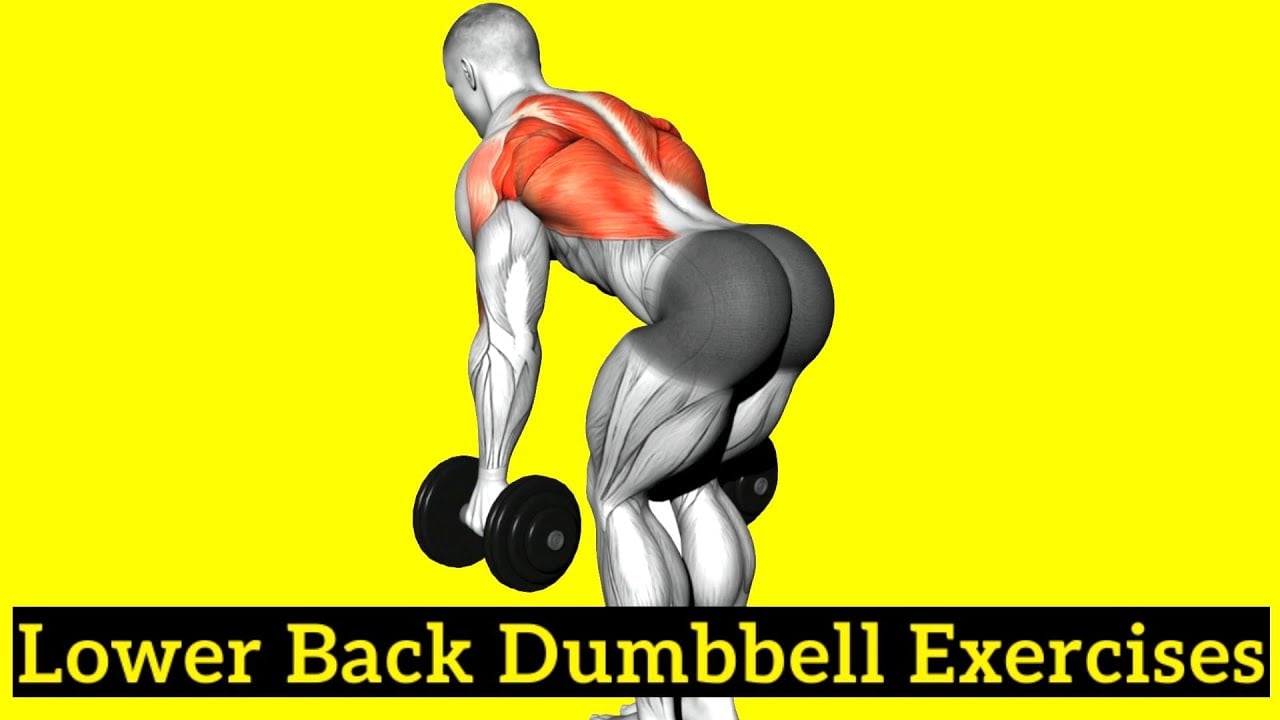A strong lower back is not just about alleviating aches and pains; it’s the cornerstone of good health and fitness.
Why? Having a strong lower back provides enormous benefits. The lower back muscles support your spine, improve your posture, and allow you to lift heavy objects safely.
And the good news is that dumbbells offer an easy and effective way to strengthen your lower back at home or the gym. They effectively target your lower back muscles from different angles for a complete workout.
Dumbbell allows unilateral training (training one limb at a time), increases core stability, and improves muscular imbalances. They allow a greater range of movement (ROM) that improves lower back muscle recruitment.
In this guide, I’m sharing my 10 favorite (based on science and experience) lower-back dumbbell exercises you can do at home or the gym.

- 10 Best Dumbbell Lower Back Exercises
- 1. Dumbbell Deadlift
- 2. Dumbbell Bent Over Row
- 3. Dumbbell Renegade Row
- 4. Dumbbell Superman
- 5. Dumbbell Wood Chopper
- 3. Dumbbell Good Morning
- 7. Standing Dumbbell Twist
- 8. Dumbbell Glute Bridge
- 9. Dumbbell Bird Dog
- 10. Dumbbell Swings
- Lower Back Workout Routines
- 1. Beginner’s Workout Plan
- 2. Intermediate Workout Plan
- Anatomy Of Lower Back Muscles
- Erector Spinae
- Quadratus Lumborum
- Multifidus
- Latissimus dorsi
- FAQs
- What is the king of lower back exercises?
- Is it safe to do dumbbell lower back exercises at home?
- Conclusion
- References
- Disclaimer
10 Best Dumbbell Lower Back Exercises
Adding dumbbell exercises into your routine will help you build lower back muscle and strength. The low back workout with a dumbbell is divided into dumbbell deadlift and Dumbbell row.
1. Dumbbell Deadlift
The dumbbell deadlift is a versatile and effective exercise for the lower back. It targets the vital erector spinae and quadratus lumborum muscles and engages other major back muscle groups.
The dumbbell deadlift is the best variation of the classic barbell deadlift. It is a powerful exercise that builds an overall body by using more muscles than any other exercise.
If you were looking for one exercise you could do at home to work your whole body, including your lower back, upper back, triceps, legs, and buttocks, I would recommend the dumbbell deadlift.
The other best variation of dumbbell deadlift to build lower back strength is:
- Single-Leg Dumbbell Deadlift: This unilateral exercise targets one leg at a time. It is excellent for improving balance and engaging your core.
- Dumbbell Sumo Deadlift: Wider stance and targets the inner thighs and glutes more. The wider stance also tends to be easier on the lower back.
- Dumbbell Romanian Deadlift: The Romanian deadlift focuses more on the hamstrings and lower back and less on the quads. It is performed by hinging at the hips while maintaining a slight knee bend.
- Dumbbell Stiff-Leg Deadlift: This variation is similar to the Romanian deadlift but emphasizes even straighter legs and a higher hinge at the hips. It’s great for isolating the hamstrings and lower back muscles.
- Dumbbell Suitcase Deadlift: In the suitcase deadlift, you only hold a dumbbell on one side of your body, mimicking lifting a suitcase. This creates a unique challenge for your lower back, core, and obliques, as they work to keep your body balanced.
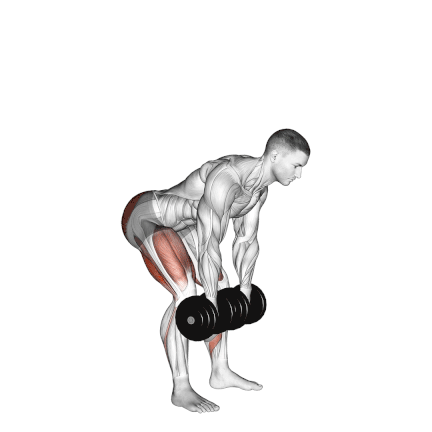
How To Do
- Stand with feet shoulder-width apart, toes pointing forward
- Hold a pair of dumbbells in front of your thighs, palms facing your body
- Brace your core and keep your back straight
- Push your hips back and simultaneously hinge forward at your waist as you bend at your knees.
- Keep the dumbbells close to your body.
- Do not go through half of the exercise; complete the lift.
- Reverse the movement to get back to the starting position.
2. Dumbbell Bent Over Row
Bent-over dumbbell rows are another fantastic exercise for your lower back. This exercise targets the muscles in your upper, middle, and lower back for stabilization.
It is a compound exercise that works the back muscles, including the latissimus dorsi, rhomboids, and trapezius. It also works the biceps and forearms.
You can also try a one-arm dumbbell row to strengthen the muscles that support good posture and reduce the risk of back pain. You can do it at home or the gym with just a dumbbell and a bench or stable surface.
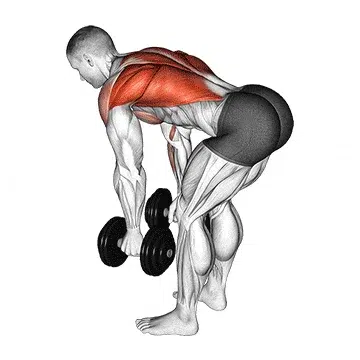
How To Do
- Take a narrow stance and hold two dumbbells with a neutral grip in each hand.
- Bend your torso forward at an angle of 45 degrees to the floor with your knees slightly bent.
- Make sure you are not using more weight than you can handle.
- Keep your back straight and avoid rounding your shoulders
- Use the back and raise the dumbbell until it touches the abdominal region.
- Keep your body straight from your shoulders to your ankles as you row the weight.
- Lower the dumbbell slowly to the starting position.
- Perform 3–4 sets of 8–12 repetitions
- Exhale as you pull the dumbbells up and inhale as you lower them.
3. Dumbbell Renegade Row
The Renegade row is essentially a plank combined with a dumbbell row. It is a full-body exercise that simultaneously activates the lower back, core, and upper body simultaneously.
Renegade row is an exercise that tones your back and works your core while testing your balance and stability.
It is the ultimate form of functional strength training you can easily do with dumbbells at home.
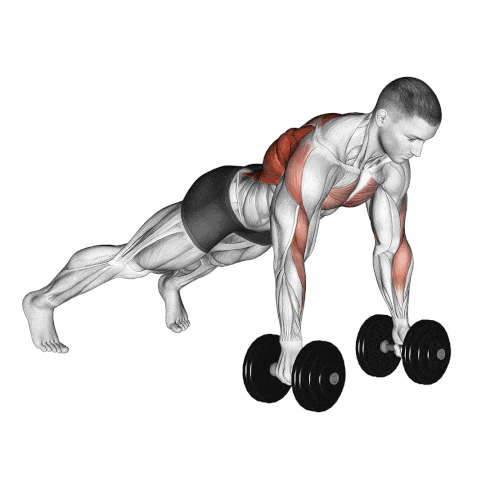
How To Do
- Place two dumbbells on the floor about shoulder-width apart.
- Start in a plank position with your hands on a pair of dumbbells
- Keep your body straight from your shoulders to your ankles as you row the weight.
- Always keep your core tight to maintain stability and protect your lower back.
- Pull the right elbow back and raise the dumbbell toward the chest. Keep the elbow close to the torso. Hold for one second.
- Then, slowly return the weight to the starting position to repeat on the other side.
- Complete the desired number of repetitions.
- Make sure you complete the same number of repetitions for each arm.
4. Dumbbell Superman
The Dumbbell Superman is a simple, yet effective movement you should incorporate into your low back workout routines.
The Dumbbell Superman exercise focuses on strengthening the erector spinae muscles. The traditional Superman move is modified with dumbbells for additional resistance.
It not only targets the lower back, but it also works the glutes, hamstrings, and shoulder to some extent.
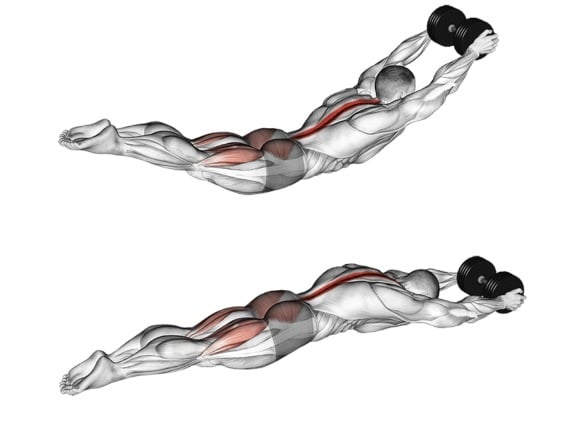
How To Do
- Lie flat on your stomach on a mat or soft surface.
- Hold light dumbbells in front of you. Grip the dumbbells securely.
- Your legs are straight, and your feet are together.
- Inhale and simultaneously lift both your arms and legs as high off the ground as comfortably as possible.
- At the top of the lift, momentarily squeeze your glutes and lower back muscles.
- Exhale and gently lower your arms and legs back to the starting position.
- Perform 2-3 sets of 8-12 repetitions.
- Start with a small range of motion and gradually increase it as you progress.
5. Dumbbell Wood Chopper
People usually focus on doing exercises like deadlifts and rows (for good reason) to strengthen the lower back.
But if you are looking for a dynamic movement that engages not only your lower back but also your core, shoulders, and hips, the Dumbbell wood chop is a great choice.
This is great for strengthening the twisting movement pattern of your torso and improving its ability to resist twisting forces.
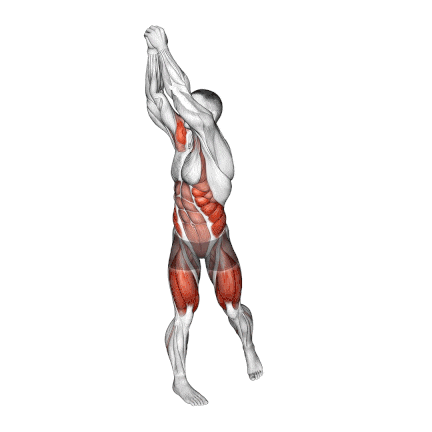
How To Do
- Don’t lift too much weight. Start with a weight that you can handle with good form.
- Hold the dumbbell with both hands, with either your fingers interlaced or with one hand over the other. Stand shoulder-width apart.
- Keep your arms straight and rotate the dumbbell diagonal downward until your torso turns to the other side and your hands are at knee height.
- Make sure to pivot your foot properly to allow for smooth hip rotation and to avoid straining the knees.
- Hold for a count of two. Then, slowly reverse the movement to return to the starting position.
- Repeat for the prescribed number of repetitions. Repeat the exercise on your opposite side.
- Breathe out as you twist your torso, and breathe in as you return to the starting position.
Know More: 12 Best Dumbbell Oblique Exercises For A Stronger Core
3. Dumbbell Good Morning
Try the Dumbbell Good Morning exercise if you’re looking for a new way to work your lower back.
It primarily targets the muscles in your lower back, specifically the erector spinae, and also works your hamstrings and glutes.
If you are new to good mornings, starting with a bodyweight or a light weight is a good idea and gradually increasing the weight as you get stronger.
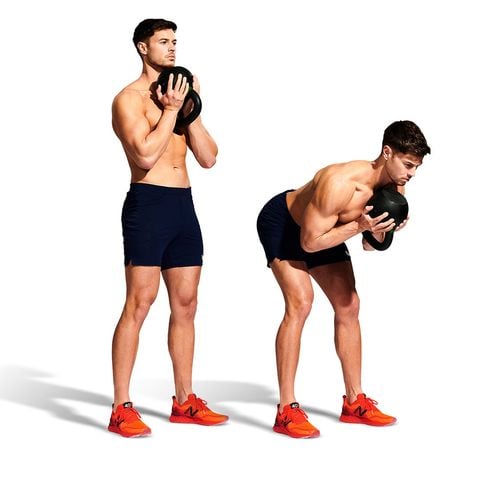
How to Do
- Stand up straight with your feet shoulder-width apart. Hold the dumbbells in front of you.
- Keep your back straight, chest up, and core engaged.
- Hinge forward at the hips and push them back while keeping your knees slightly bent.
- Lower your upper body towards the ground.
- Reverse the motion to revert to the starting point.
- Do 3-4 sets of 10–15 repetitions.
7. Standing Dumbbell Twist
The Standing dumbbell twist is a rotational exercise that engages your core and lower back muscles.
Unlike traditional lower back exercises that involve hinging or rowing, this move incorporates a twisting motion, effectively working your obliques, abdominals, and lower back simultaneously.
It looks simple, but it’s a real challenge. If you are a beginner, keep a dumbbell close to your body. Straightening your arms can increase the difficulty.
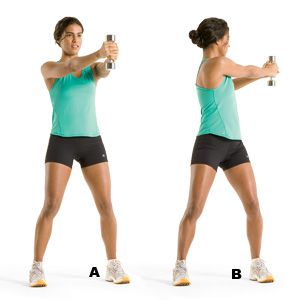
How To Do
- Stand tall with your feet shoulder-width apart.
- Hold a dumbbell with both hands in front of your chest.
- Engage your core muscles to maintain stability throughout the exercise.
- Twist your torso to the right side comfortably while maintaining control and balance.
- Pause briefly at the end of the twist to feel the contraction in your oblique muscles.
- Slowly return to the starting position and repeat the twist on the opposite side.
- Continue alternating twists from side to side for the desired number of repetitions.
8. Dumbbell Glute Bridge
The Dumbbell Glute Bridge is an excellent exercise for targeting the glutes, lower back, hamstrings, and core.
It is a variation of the standard bodyweight glute bridge. Adding a dumbbell makes the muscles work harder, strengthening the lower back and glutes.
This simple exercise can be done at home or in the gym. All you need is a dumbbell and a flat surface.
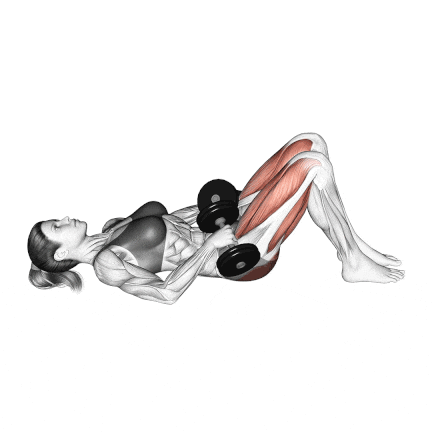
How To Do
- Lie on your back with your knees bent and your feet flat on the ground
- Hold a dumbbell or dumbbells on your hips with both hands
- Lift your hips off the ground until your body forms a straight line from your shoulders to your knees.
- Focus on squeezing your glutes at the top of the movement.
- Pause briefly, then lower your hips back down to the starting position
- Continue for the desired number of repetitions.
9. Dumbbell Bird Dog
The Dumbbell Bird Dog is a unilateral exercise that challenges balance and coordination while engaging your lower back, core, and glutes.
Dumbbells make the traditional bird dog exercise harder and work more muscles.
The balancing aspect of this exercise is excellent for improving your sense of proprioception.
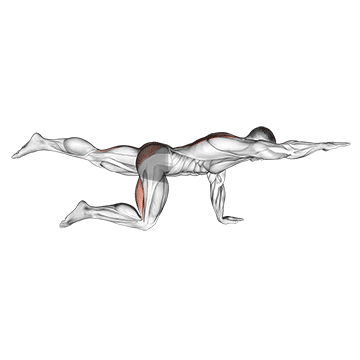
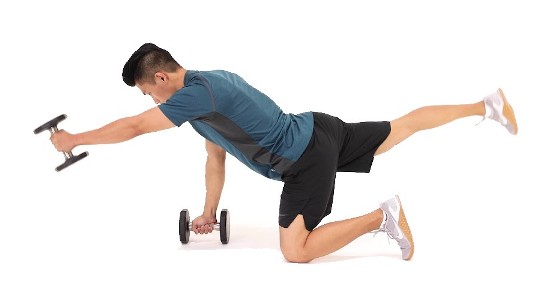
How To Do
- Start on your hands and knees with your back straight.
- Maintain a neutral spine; don’t arch your lower back.
- Keep neck in line with spine; don’t crane upwards
- Hold a dumbbell in each hand, with your arms extended at your sides.
- Extend one arm and the opposite leg out in front of you, keeping your core engaged.
- Hold for a second, then return to the starting position and repeat on the other side.
10. Dumbbell Swings
The dumbbell swings are a full-body workout that targets the hips, glutes, and lower back, as well as working the shoulders and arms.
This exercise requires you to generate power from your hips to swing a dumbbell in an arc-like motion in front of you. It’s an explosive move that combines strength and cardiovascular training.
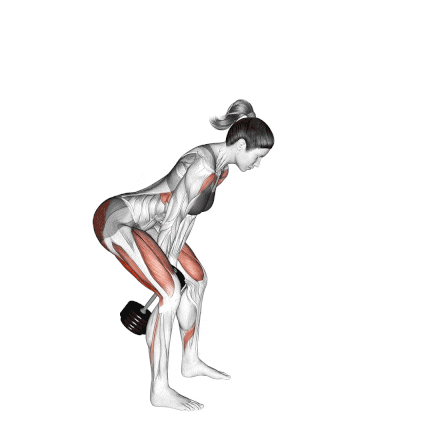
How To Do
- Stand with your feet shoulder-width apart and hold a dumbbell with both hands.
- Push your hips back and slightly bend your knees, lowering the dumbbell between your legs.
- Thrust your hips forward to swing the dumbbell up to shoulder height or slightly higher.
- Slowly lower the dumbbell back down to the starting position.
Lower Back Workout Routines
This workout routine focuses on strengthening the lower back muscles using dumbbell-only exercises.
1. Beginner’s Workout Plan
This beginner’s workout plan can be done at home or in a gym setting. It targets the hamstrings, glutes, and lower back muscles.
Frequency: 2–3 times a week
| Exercise | Sets | Reps |
|---|---|---|
| Dumbbell Deadlifts | 3 | 10 |
| Bent-over Dumbbell Rows | 3 | 10 |
| Dumbbell Glute Bridge | 3 | 10 |
| Dumbbell Bird Dog | 3 | 8 per side |
2. Intermediate Workout Plan
| Exercise | Sets | Reps |
|---|---|---|
| Dumbbell Deadlifts | 4 | 12 |
| Dumbbell Romanian Deadlift | 3 | 12 |
| Bent-over Dumbbell Rows | 4 | 12 |
| Dumbbell Swings | 3 | 20 swings |
| Dumbbell Superman | 3 | 15 |
Anatomy Of Lower Back Muscles
The lower back is more than just a single muscle; it’s a complex system of interconnected muscles, tendons, and ligaments.
Two of the most prominent lower back muscle groups worth highlighting are the Erector Spinae and the Quadratus Lumborum.
This complex network of muscles that work together to support the spine, bend and twist the torso, and move the legs.
Erector Spinae
The Erector Spinae is not one single muscle but a group of muscles and tendons running more or less parallel to the spine. These muscles extend from the lower back to the upper neck.
It is divided into the spinalis, iliocostalis, and longissimus. The erector spinae muscles help to extend the spine and to keep it upright.
The erector spinae are often the muscles that come to mind when we think of “back strength,” and they play a vital role in actions like lifting, pulling, and even simple tasks like standing up straight.
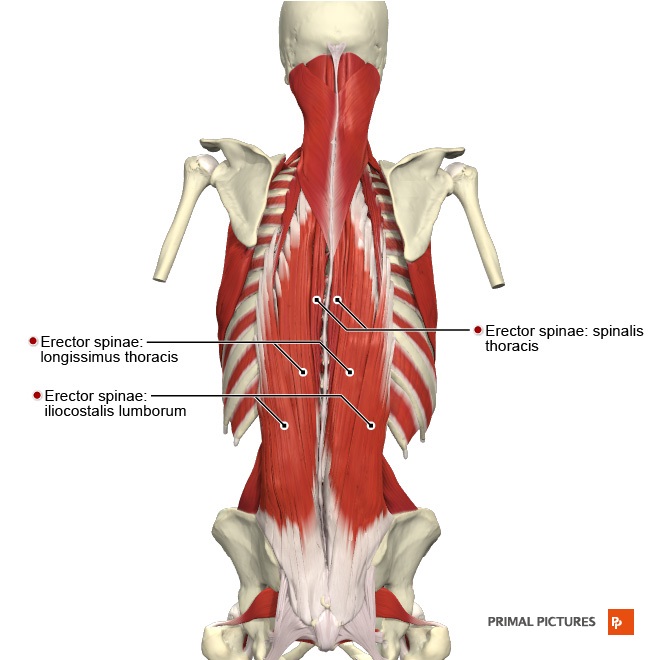
Quadratus Lumborum
The Quadratus Lumborum is a deep muscle that originates in the hip and attaches to the lower ribs and the lumbar spine.
This muscle is crucial for spinal stabilization and is heavily engaged in activities that require side-bending or hip hiking. It’s often overlooked but is vitally important for maintaining a healthy lower back and core.
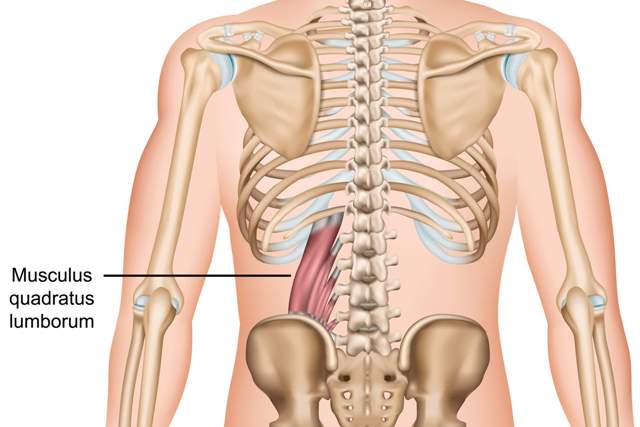
Multifidus
This muscle is located deep in the lower back and it runs along each side of the spine. It helps to stabilize the spine and to prevent it from moving too much.
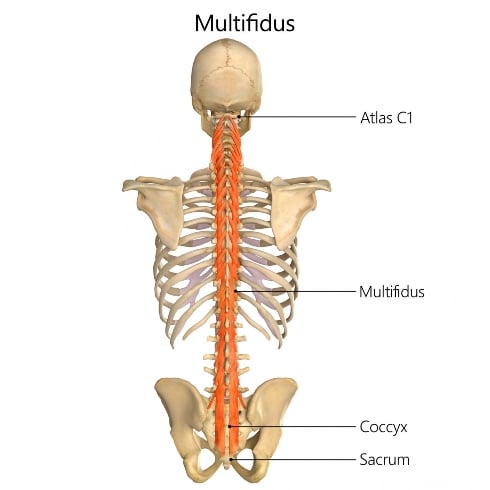
Latissimus dorsi
This muscle is located in the upper back and it extends down to the lower back. It helps to extend the spine and to pull the arms down towards the body.
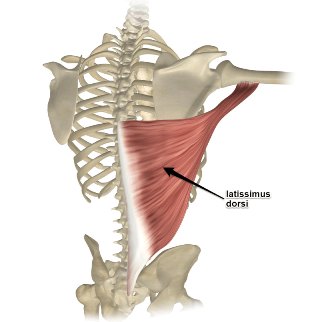
These are just some of the many muscles that make up the lower back.
FAQs
What is the king of lower back exercises?
The deadlift is considered the king of lower back exercises. It is one of the larger compound exercises that targets multiple muscle groups, including the lower back, glutes, and hamstrings. No other single exercise challenges the lower back while training the full backside of the body like the deadlift.
Is it safe to do dumbbell lower back exercises at home?
Yes, dumbbell back exercises can be safely done at home, provided you use proper form, start light, and build up slowly. Pay close attention to technique.
Conclusion
Your lower back is the link between your upper and lower body. It helps you walk, run, lift, and bend. When it’s not flexible or strong, it affects your posture, relaxation, and even your ability to get hurt.
Dumbbell exercises offer an incredibly effective, versatile, and accessible means to fortify your lower back. The range of exercises discussed—from Dumbbell Deadlifts to Dumbbell Bird Dogs—gives you multiple options to target this.
These exercises not only help build and tone muscles, but they also help improve posture, balance, and daily functionality.
If you work, you can build a more muscular, more resilient lower back. So grab those dumbbells and start today on the path to a fitter and healthier you.
References
- James Rainville, Carol Hartigan, Eugenio Martinez, Janet Limke, Cristin Jouve, Mark Finno: Exercise as a treatment for chronic low back pain. PMID: 14749199 DOI: 10.1016/s1529-9430(03)00174-8
- Rahman Shiri, David Coggon: Exercise for the Prevention of Low Back Pain: Systematic Review and Meta-Analysis of Controlled Trials: American Journal of Epidemiology, Volume 187, Issue 5, May 2018, Pages 1093–1101
- Suh, Jee Hyun MD; Kim, Hayoung BS; Jung, Gwang Pyo MD; Ko, Jin Young MD; Ryu, Ju Seok MD, PhD: The effect of lumbar stabilization and walking exercises on chronic low back pain: June 2019 – Volume 98 – Issue 26 – p e16173 doi: 10.1097/MD.0000000000016173
- Manniche C, Lundberg E, Christensen I, et al. Intensive dynamic back exercises for chronic low back pain: a clinical trial. Pain 1991;47:53–63.
- Hartigan C. Exercise-based therapy for low back pain. https://www.uptodate.com/contents/search. Accessed April 19, 2023.
- Spine conditioning program. American Academy of Orthopaedic Surgeons. https://orthoinfo.aaos.org/en/recovery/spine-conditioning-program/. Accessed April 19, 2023.
- Dutton M. Lumbar spine. In: Dutton’s Orthopaedic Examination, Evaluation, and Intervention. 6th ed. McGraw Hill; 2022. https://accessphysiotherapy.mhmedical.com. Accessed April 24, 2023.
Disclaimer
This article is intended for general informational and educational purposes only and not to replace professional medical advice, diagnosis, or treatment. Always talk to a qualified healthcare provider or fitness professional before starting a new exercise program or changing your current routine.

Manish is a NASM-certified fitness and nutrition coach with over 10 years of experience in weight lifting and fat loss fitness coaching. He specializes in gym-based training and has a lot of knowledge about exercise, lifting technique, biomechanics, and more.
Through “Fit Life Regime,” he generously shares the insights he’s gained over a decade in the field. His goal is to equip others with the knowledge to start their own fitness journey.

